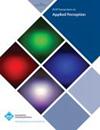逼真投掷动画运动编辑的感性评价
IF 1.9
4区 计算机科学
Q3 COMPUTER SCIENCE, SOFTWARE ENGINEERING
引用次数: 12
摘要
在游戏开发过程中的动画预算限制通常要求使用有限的通用动作集。因此,编辑操作通常需要动画虚拟角色具有足够的多样性。因此,评估编辑动画的感知合理性可以大大有助于制作视觉上可信的动画。在本文中,我们研究了观察者对臂上和臂下生物投掷动画操作的敏感性。在第一个实验中,我们修改了球的释放速度,同时保持虚拟投掷者的运动和球的释放角度不变。在第二个实验中,我们评估了进一步修改投掷动画的可能性,通过同时编辑投掷者的运动和球的释放速度,使用动态时间扭曲。在这两个实验中,我们发现参与者认为短臂下抛球特别不自然。我们还发现,除了修改球的释放速度外,修改投掷者的运动并不能显著提高编辑过的投掷动画的感知合理性。在第三个实验中,我们在保持球的释放速度大小和投掷者的运动不变的情况下修改了球的释放角度,发现这种编辑操作对于提高短臂下投掷的感知合理性是有效的。最后,在实验4中,我们用一个机械投掷装置(一个斜坡)代替了虚拟的人类投掷者,发现了对释放速度变化的相反的敏感性模式,这表明生物投掷和物理投掷受不同的感知规则约束。我们的研究结果通过指定投掷操作的感知合理性阈值,为游戏和虚拟现实应用的开发人员提供了有价值的指导,同时也为生物运动的视觉感知研究人员提供了一些有趣的见解。本文章由计算机程序翻译,如有差异,请以英文原文为准。
Perceptual Evaluation of Motion Editing for Realistic Throwing Animations
Animation budget constraints during the development of a game often call for the use of a limited set of generic motions. Editing operations are thus generally required to animate virtual characters with a sufficient level of variety. Evaluating the perceptual plausibility of edited animations can therefore contribute greatly towards producing visually plausible animations. In this article, we study observers’ sensitivity to manipulations of overarm and underarm biological throwing animations. In the first experiment, we modified the release velocity of the ball while leaving the motion of the virtual thrower and the angle of release of the ball unchanged. In the second experiment, we evaluated the possibility of further modifying throwing animations by simultaneously editing the motion of the thrower and the release velocity of the ball, using dynamic time warping. In both experiments, we found that participants perceived shortened underarm throws to be particularly unnatural. We also found that modifying the thrower's motion in addition to modifying the release velocity of the ball does not significantly improve the perceptual plausibility of edited throwing animations. In the third experiment, we modified the angle of release of the ball while leaving the magnitude of release velocity and the motion of the thrower unchanged, and found that this editing operation is efficient for improving the perceptual plausibility of shortened underarm throws. Finally, in Experiment 4, we replaced the virtual human thrower with a mechanical throwing device (a ramp) and found the opposite pattern of sensitivity to modifications of the release velocity, indicating that biological and physical throws are subject to different perceptual rules. Our results provide valuable guidelines for developers of games and virtual reality applications by specifying thresholds for the perceptual plausibility of throwing manipulations while also providing several interesting insights for researchers in visual perception of biological motion.
求助全文
通过发布文献求助,成功后即可免费获取论文全文。
去求助
来源期刊

ACM Transactions on Applied Perception
工程技术-计算机:软件工程
CiteScore
3.70
自引率
0.00%
发文量
22
审稿时长
12 months
期刊介绍:
ACM Transactions on Applied Perception (TAP) aims to strengthen the synergy between computer science and psychology/perception by publishing top quality papers that help to unify research in these fields.
The journal publishes inter-disciplinary research of significant and lasting value in any topic area that spans both Computer Science and Perceptual Psychology. All papers must incorporate both perceptual and computer science components.
 求助内容:
求助内容: 应助结果提醒方式:
应助结果提醒方式:


